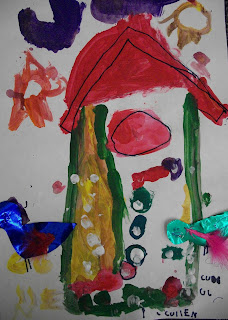Here's how we did it:
Une: We drew our green cities on watercolor paper with pencils (could jump right into black sharpies, but I wanted kids to spend the time making extraordinary details). Imagination was encouraged and the use of groundlines, waterlines, buildings, transportation...etc was discussed.
Deux: I pulled out the tube watercolors, which I usually use with the older students, in various shades of green, yellow, and blue watercolors to paint them. I showed the students how to mix colors then dared them to create as many shades of green, turquoise, lime, chartreuse, aqua, and teal they could!
Trois: Once dried completely, we finished these paintings by outlining all our lines in black sharpies.
Eddie
Gaia
Victoria
Nicholas
Megan
Adric
Aidan
Chloe
Luke
Maddy
William
Yula
























































